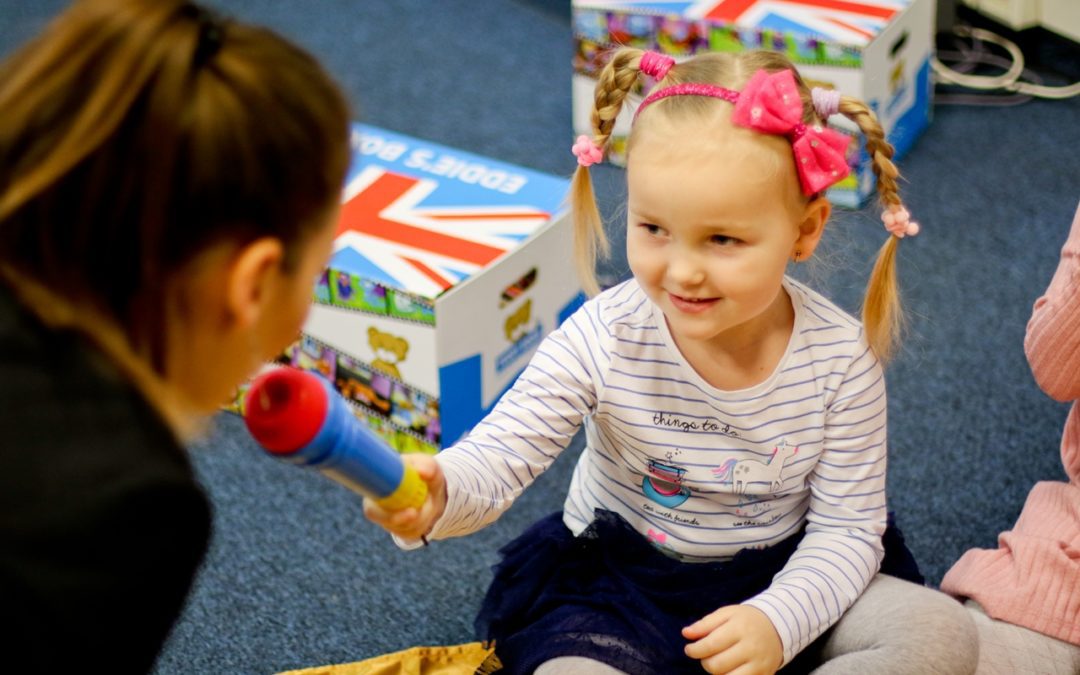The information that students are afraid to speak comes back to foreign language teachers like a boomerang. Studying for many years in school or on courses, we may learn how to write essays, complete sentences with the correct grammatical forms or understand a perfectly read text… but independent, fluent and free speaking frequently turns out to be an impassable barrier.
Does this sound familiar?
What if I tell you that the language barrier might have been nurtured through your child’s standard foreign language education in school? Answering at the board, to get a grade of course, thirty other (sometimes cruel) children who are just waiting for a slip of the tongue, the school bell that hurries everyone along, boredom, textbooks, formula…
Free your child from the way that most Polish schools try to teach English. It is good to know how to work on the ability to speak fluently (regardless of the language proficiency level) outside school, using different kinds of activities or at home with a parent.
However, before moving on to the five techniques that I have prepared for you, I want to confirm this – yes, you did read the previous sentence correctly.
The ability to speak freely in English has nothing to do with the language proficiency level, the number of known words or grammatical tenses.
- Free speaking starts from confidence in using English.
- Free speaking starts from breaking out of the fear of making a mistake (I will tell you a secret – even native speakers sometimes mispronounce words).
- Free speaking can be something habitual, practised, and eventually acquired
Here are five techniques for breaking the language barrier in children studying a foreign language which can be used by both a teacher during classes and a parent at home.
1. Give your child a mike
First things first: a toy microphone is… a toy. The presence of a toy while learning calms things down in the eyes of a child. Initially shy children usually agree to say something out loud just to get the chance to hold the mike for a moment on their own. It is not a coincidence that in Teddy Eddie English lessons for children we use exactly this approach.
Another completely different role of a mike is that it provides a slightly safer environment for the child. Have you ever covered yourself while arguing with someone? Seemingly taking a sip of tea or holding a mug in both your hands or holding a file clutched tightly to your body. This is an entirely natural psychological mechanism! Let the child cover their mouth while talking with a mike if they need that and then, with each new attempt there will be more and more progress.
2. Let them speak up
Little children, still in primary school, learn how to freely and fluently articulate their thoughts with multiple complex sentences. But what about in the presence of an adult? And what about in a foreign language? Unfortunately, we adults are sometimes too impatient or we simply do not allow the child to speak up. Why is that? Sometimes it can be due to time pressure if it happens during classes. Other times it is because Mum is already thinking about the next question. However, sometimes the reason is pure excitement – we are so excited that, maybe, our child will say something in English in a moment and we are so happy… that we ourselves demonstrate that we too know how to say it. To make matters worse, occasionally we finish the sentence for a child before they have even had the time to put the thought together in their own head correctly.
Free speaking is not a zero-one system – one day, a child does not speak at all, the next, he or she speaks fluently. To begin with, free speaking may mean the ability to articulate a complete sentence that takes three times longer than you would expect. Therefore, let the child speak. Listen patiently.
3. Voice messages
We are living in the 21st century! This means that we have all the technology at our disposal in fighting the language barrier. If you know that a child knows the words and you feel that they are able to say them, and despite that, you are not able to “squeeze out” a sentence spoken aloud – try recording a voice message.
You can use a voice recorder on a phone, voice messages on Facebook Messenger or Instagram – anything that is convenient. Allow a child to speak at their own pace and to decide whether the recorded voice message should be deleted and a new one recorded – by doing this you give the child a great sense of security.
Do you want more? Record a message for your child as a special agent – “Pshhh, base here, pshhh, come in please, do you copy? Over! Pshhh, what country do you live in and how old are you? Pshhh.” (Of course, you record the message in English.) Next, the child listens to your message from the comfort of their own room in a “fun mode”, and, as a special agent, responds to the message. Over and out!
Once you are comfortable with recording messages, you can move to a higher level! Record something for your friend, cousin or aunt – anybody that currently lives in another country. This is a way of showing that language and learning is not only art for art’s sake – it should be used for communication.
4.Can’t speak? Then let them teach others!
There isn’t a lot of time and space here for an extensive explanation so you have to trust me with this. The most effective way of learning anything is teaching that material to somebody else. And you do not have to wait until your child is an expert at speaking in order to share their knowledge and experience. Speaking a little bit more than the student is enough to be able to teach. And who speaks English worse than a child? A doll, a teddy bear and a dinosaur, of course.
Organise a demo lesson for toys so that the child can play the role of the teacher. There are endless advantages to this method, especially if a child is really committed to teaching. Psychologically it can allow a child to develop a different perception of themselves. Not as a beginner or as someone who doesn’t know very much but as someone who has an important job to do. In addition, teaching someone means that the child systematises their knowledge and practises everything as many times as they need…. erm – as the dolls and dinosaurs need.
5. Read out
Simple, right? If your child has started reading, let them read easy texts in a foreign language out loud. How can this tactic help in speaking? While reading out loud, a child gets used to their voice uttering words in a foreign language. Moreover, they practise their accent, pronunciation and utterance of expressions and typical phrases. While reading, even the muscles (sic!) have a chance to remember the tongue movements necessary to utter, as an example, the famous English “TH” which is unnatural for us and can cause some problems at first. If the muscles (and thus the brain) remember that they have already said the particular word or phrase out loud multiple times – it will be easier for a child to use the same sounds but this time in order to speak independently and freely.
About the Author:
Angelika M. Talaga is a neuropedagogue, a parenting coach and a populariser of science. In her private life, she is a wife and mother. Every day she transforms her knowledge and experience into tools, methods and strategies which help parents to raise creative, resourceful, thinking children.
__________________________________________________________________
Learn more about the Teddy Eddie method HERE






